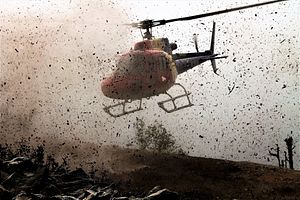A high-profile helicopter crash in Nepal on February 27 killed seven people, including Nepali Minister for Culture, Tourism, and Civil Aviation Rabindra Adhikari.
Adhikari, 49, was a popular young leader of the ruling Nepal Communist Party (NCP). He had undertaken a series of policies to reform Nepal’s civil aviation sector since assuming the position in February last year. Ironically, he fell victim to a tragic aviation accident. A Dynasty Air helicopter carrying Adhikari crashed in eastern Nepal this week as he was returning to Kathmandu after inspecting a possible site for the construction of a new airport. Six other passengers, including other high-level government officials, also died. The initial investigation has identified bad weather as the cause of the crash.
After taking the helm at the Ministry of Culture, Tourism and Civil Aviation, Adhikari took prompt steps to improve conditions at Nepal’s only international airport, Tribhuvan International Airport, and pursued the reactivation of several domestic airports. One of his priorities was to convince the European Commission to remove Nepal from its aviation safety lists. He held several rounds of talks and some of the steps he’d undertaken were recognized by the EU regulatory body.
The high-profile crash has added additional challenges to Nepal’s ongoing efforts to come off the ban list. Nepal airlines were banned from flying to Europe owing to their weak safety standards as of 2013. Officials say the latest crash has sent a negative message to the international arena about aviation safety in Nepal. Officials fear that the high profile cash could be another pretext for the EU to delay removing Nepal from the ban list.
Following a safety audit,* the International Civil Aviation Organization (ICAO) removed Nepal’s carriers from the Significant Safety Concern (SSC) list in June last year. In June, ICAO awarded Nepal with an ICAO Council President Certificate for taking steps to improve aviation security. The EU body, however, remained reluctant to remove Nepal’s carriers from its ban list, denying the growth of tourism to the country.
In the last several years, Nepal has become increasingly serious about improving its aviation safety — including it as a priority in key national documents — but the situation has not improved significantly.
Crash figures show that there has not been substantial improvement. According to the 2018 Aviation Safety Report from Nepal’s Civil Aviation Authority, Nepali-registered aircraft had 30 accidents that claimed 173 lives during the period of 2008 to 2017. Similarly, there were 10 helicopter accidents with 16 fatalities and three recreational aircraft accidents with five fatalities.
2018 was not a good year for the aviation sector as there were at three fatal accidents. On March 12, 2018, a US-Bangla plane crashed while landing in Tribhuvan International Airport, killing 51 passengers; on May 16, two pilots were killed when a Makalu Air plane crashed in Humla district of Nepal; and in September, an Altitude Air helicopter crashed in Nuwakot district, killing six people. 2017 and 2016 were safer years compared to 2018.
Soon after each plane crash, the government forms a probe panel. The probe panel eventually submits its report but there have been complaints that their recommendations are not effectively implemented. Various reports have suggested launching a voluntary reporting system emphasizing a nonpunitive environment so that patterns of unsafe behavior among aviation personnel are noticed.
Government officials claim that accidents are taking place due to human or technical errors or bad weather. A senior official at the Civil Aviation Authority of Nepal (CAAN) said that there would be a full-fledged security check of all helicopters and planes before they take off. “The engineers with a license from the Civil Aviation Authority of Nepal check the engines and the flight takes off when it is certified,” he said. According to him, the same applies to international flights as well.
In an in-depth article published in the 2017 CAAN, Former Director General of CAAN Rajesh Raj Dali wrote: “To maintain the safety standard in accordance with ICAO, there must be Continuous Monitoring Approach (CMA). Computer-based training (CBT) must be conducted to prepare auditors and experts to perform CMA activities, including ICAO Coordinated Validation Missions (ICVMs) and USOAP audits.” He argued that there should be a plan of action to resolve, in a timely manner, ICAO-identified Significant Safety Concerns (SSCs) and/or safety oversight deficiencies.
Along with huge investment from the Nepali government, there has been external support to improve aviation security in Nepal. The Japan International Cooperation Agency (JICA) in 2016 signed an agreement with Nepal to provide grant aid of up to 1.452 billion yen for assistance in improving aviation safety at Nepal’s major airports. The objective of the project was to provide aviation safety facilities and other equipment at eight major airports in Nepal, including Tribhuvan International Airport.
As Nepal focuses on tourism, it needs to improve its aviation security in order to attract more tourists. Nepal announced the “Visit Nepal Year 2020” initiative, hoping to attract increasing numbers of tourists. Due to the lack of proper road infrastructure to reach the country or travel around it, international tourists prefer to travel by air. Travel on highways and roads is frequently disrupted due to floods and landslides. Helicopters are often used to travel in rural areas and it is the only means of transport to rescue sick or injured tourists from such areas. Nepal clearly needs to take additional steps without delay to improve aviation security if it hopes to make the most of the tourism boom the government wants to spark.
*The sequence of events leading to the ICAO SSC removal has been updated.
Kamal Dev Bhattarai is a Kathmandu-based writer and journalist.
Correction: An earlier version of this article stated that the EU Air Safety list is managed by the European Aviation Safety Agency. It is managed by the European Commission.

































